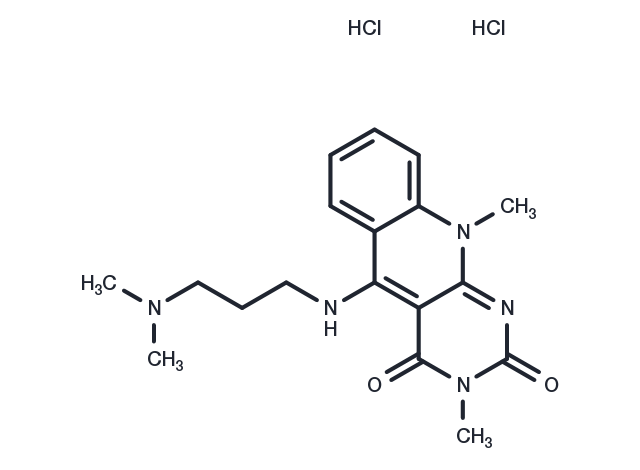Powder: -20°C for 3 years | In solvent: -80°C for 1 year


HLI373 dihydrochloride is a potent Hdm2 inhibitor, efficiently restraining the ubiquitin ligase activity of Hdm2 and effectively prompting apoptosis in DNA-damaging agent-sensitive tumor cells[1]. Additionally, HLI373 dihydrochloride exhibits antimalarial activity[2].

| Description | HLI373 dihydrochloride is a potent Hdm2 inhibitor, efficiently restraining the ubiquitin ligase activity of Hdm2 and effectively prompting apoptosis in DNA-damaging agent-sensitive tumor cells[1]. Additionally, HLI373 dihydrochloride exhibits antimalarial activity[2]. |
| In vitro | HLI373 (3-15 μM; 15 hours) selectively kills tumor cells harboring wild type p53[1].HLI373 (10-50 μM) stabilizes cellular Hdm2 in a dose-dependent manner. HLI373 (3 μM) activates p53 transcription[1].HLI373 selectively inhibits auto-ubiquitylation of Hdm2[1].Co-transfection with plasmids encoding p53 and Hdm2 results in degradation of p53. Incubation with HLI373 (5-10 μM; 8 hours) blocks p53 degradation. HLI373 increases p53 and Hdm2 protein levels in cells[1]. HLI 373 also shows lower IC50 values (below 6 μM) against both chloroquine-sensitive P. falciparum D6 strain (PfD6) and chloroquine-resistant P. falciparum W2 strain (PfW2) and exhibits early growth inhibition[2]. HLI-373 is a MDM2 inhibitor interrupting its ubiquitin E3 ligase activity, could abolish the ubiquitylation of its substrate protein p53. HLI-373 targets the C-terminus functioning as an E3 ubiquitin ligase[3]. Cell Viability Assay[1]Cell Line: Wild type p53 mouse embryo fibroblasts (MEFs), and p53-deficient MEFs |
| Molecular Weight | 414.33 |
| Formula | C18H25Cl2N5O2 |
| CAS No. | 1782531-99-0 |
Powder: -20°C for 3 years | In solvent: -80°C for 1 year
You can also refer to dose conversion for different animals. More
bottom
Please see Inhibitor Handling Instructions for more frequently ask questions. Topics include: how to prepare stock solutions, how to store products, and cautions on cell-based assays & animal experiments, etc.
HLI373 dihydrochloride 1782531-99-0 HLI 373 HLI373 Dihydrochloride HLI-373 Dihydrochloride HLI-373 dihydrochloride HLI373 HLI-373 HLI 373 Dihydrochloride inhibitor inhibit
